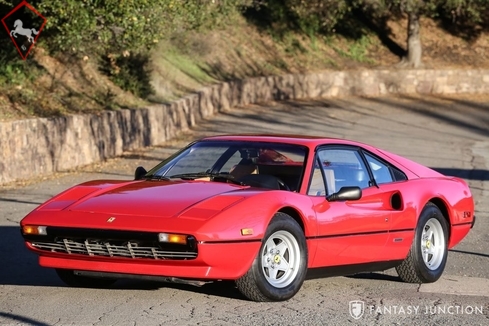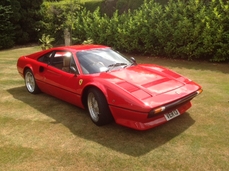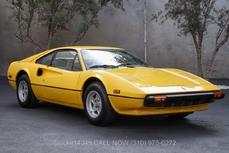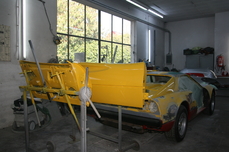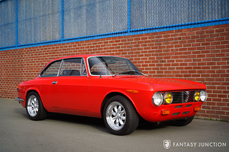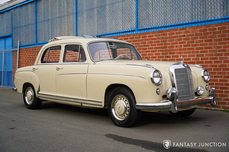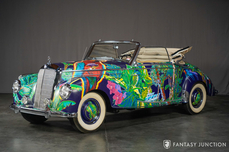Ferrari 308 GTB 2.9 Liter V8 1976
General description :
1976 Ferrari 308 GTB
s/n 20435, eng. no. 02292
Rosso Corsa with Tan Interior
Introduced in 1975 at the Paris Auto Salon, Pininfarina’s take on the 308 revealed a more curvaceous and exotic looking car than Bertone’s 308 GT4 which preceded it. Pininfarina designer Leonardo Fioravanti, having already designed many of Ferrari's most celebrated cars including the Daytona, the 206/246 Dino, and Berlinetta Boxer, captured a taut new energy and
dynamism in the 308. As a replacement for the 246, the 308 became a new market maker for Ferrari. The 308 styling was dramatic and beautiful, which earned it a place in television shows and movies over the next decade, cementing it as one of the most iconic and recognizable Ferraris made.
Mechanically, the earliest cars featured the same layout of the GT4, including the transversely mounted 3.0 liter quad-cam V8 with four twin-choke Weber carburetors. Ferrari’s characteristic exploration of innovative technology led them to produce the first 308s in fiberglass, but increased demand for the car, coupled with manufacturing challenges of lower volume fiberglass construction methods, caused Ferrari to change production to with steel bodies after the first 100 or so cars. During this transition period, construction of very few steel bodied cars included carbureted engines and early period design details. Throughout its decade of production iterations, the 308 advanced Ferrari into new territories, establishing the brand in a wide range of unchartered markets while becoming more sought for their enjoyable driving traits and exceptional design.
This particular example is a rare, early steel bodied carbureted car, manufactured November 1976, and specified for US delivery. According to the serial number, the car appears to have been one of the few steel bodied cars constructed during the transition period from fiberglass to steel bodies, while still retaining the highly desirable carbureted engine. Unlike the manufacturing inconsistencies often seen in fiberglass surfacing, this steel body retains a refined finish and excellent panel gaps, set off by the thin European front bumper, fit to the car by a previous owner, and early series details. The current owner had a major engine service (including timing belt) by noted Ferrari specialist Mike Spencer roughly 500 miles ago in March 2015, also adding Michelin XWX tires at that time.
Today, this Ferrari 308 presents a confident and sound exterior look and stance, ready for driving. The paint shows light swirling, some minor surface imperfections, and one small area of paint checking on the passenger side quarter panel. The body is very nice overall, with a bubble or two in each door skin, and a few more in the splash areas behind the wheels. Close examination reveals that the car was originally painted “Fly Yellow” when originally delivered. Glass, emblems, and black trim pieces have been properly cared for, showing some imperfections in a few areas when studied up close.
Using the clever early 308 finger latches, the doors open and shut with a tight and crisp latch on both sides. Hood and deck lid open and close with ease. Both contact surfaces have clean rubber surrounds with very minor material compression with some areas showing signs of age. The wheels have been properly maintained with no major curb rash and nice silver sheen. Tires are in excellent order and give the car a proper vintage stance.
Inside the cabin, the contrasting black and tan interior displays the characteristically purposeful layout of the 308 design. This interior black and tan color combination against the red exterior truly highlights the delightful interior details in true Ferrari fashion. The bright instruments, shifter, and switch pieces come to life against the black and tan finishes. The tan leather seats, accented with touches of black, appear to be original leather based on the clean and proper surface patina. The dash and padding, steering wheel, and instruments are all preserved with very good finishes and only minor imperfections, which collectively add to the honest character of the interior. In all, the interior of the car presents cohesively with a pleasant look and feel surrounding occupants with an authentic atmosphere of the 70s.
The carbureted V8 engine and engine compartment are clean and cosmetically well-preserved, with finishes that remain factory specified (aside from red cam covers), slightly dulled in a few areas, honestly indicating the look and feel of an early carbureted car. The red cam covers are an aesthetic touch against the black air filter and other correct factory finishes. The rear zipper compartment appears to have been properly replaced as it zips smoothly open and shut, creating a taut cover for the luggage compartment with no sagging across the rear, concealing clean black carpeting. Up front, the storage compartment is also tidy and correct, displaying largely original components and finishes including a cast spare wheel indicative of early 308 origins. The undercarriage has not been detailed and reveals evidence of use in a few places, but no obvious structural or mechanical issues.
The 3.0 liter engine jumps to life with no hesitation when started using the proper procedure for a carbureted car. The car performs as one might expect with a delight and response consistent with the Weber fed engine. The early carbureted cars are preferred by enthusiasts in part for their excellent response and driver feedback, but also for the added horsepower and glorious noises. This car displays excellent carburetion. Braking and shifting are smooth and effortless delivering a driving experience that encompasses enjoyable touring or carving mild mountain roads. The GTB truly brings out the best of the Ferrari 308 design, as only an early car with these specifications can deliver thanks to their more powerful and characterful engines and the rigidity afforded by the Berlinetta platform. Original (now removed but included with the car) emissions components, a tool roll with a partially complete set of tools, jack, spare belts, and tire tools are all included with the sale.
For anyone who seeking a rare carbureted Ferrari 308 GTB, this early steel bodied car is a well-maintained example offering the enthusiast a chance to drive and enjoy a fun and cosmetically satisfying car, with all the beauty and charisma of these early cars, just as Ferrari intended when they originally built these exciting mid-engine sports cars.
Due to California state emissions requirements, this car must be sold to an out of state buyer or California dealer.
https://fantasyjunction.com/inventory/1976-ferrari-308-gtb/overview
1976 Ferrari 308 GTB 2.9 Liter V8 is listed sold on ClassicDigest in Emeryville by Fantasy Junction for $69500.
Car Facts
Car type : Car Make : Ferrari Model : 308 GTB Model Version : 2.9 Liter V8 Engine size : 2.9 Model Year : 1976 Location : Emeryville Vehicle Registration : Normal
Sold
Seller Information
Sold
People who viewed this Ferrari 308 GTB also viewed similar Ferrari listed at ClassicDigest
Other cars listed for sale by this dealer
About Ferrari
The first Ferrari road car was the 125 S introduced in 1947 and powered by a 1.5 L V12 engine, right? Well it's not quite that simple, Ferrari did in fact produce e Tipo 815, in 1940. Tipo 815 was designed by ex-Alfa Romeo engineers Alberto Massimino and Vittorio Bellentani and by Enrico Nardi under Enzo's company but legal issues with the former associate Alfa Romeo prevented Ferrari from launching the Ferrari marque at that point.
Enzo did produce a series of fine road cars in the 50's and 60's but they were merely to finance his true passion racing, wheather GT/Sports car or Grand Prix. The 50's saw the birth of Ferrari's most memorable cars, 250 GTB (tour de France) 250 Testa Rossa, 250 GT swb just to name a few.
Under the surface tension was growing though. In November 1961 long-time sales manager Girolamo Gardini made an ultimatum to Enzo: if tensions continued, he would leave the company. As a result, Gardini was ousted, as well as Scuderia Ferrari manager Romolo Tavoni, chief engineer Carlo Chiti, experimental sports car development chief Giotto Bizzarrini, and a number of others who stood by them.
Without Chiti and Bizzarrini the development of what was to become the most quintessential Ferrari and today the world's most expensive car, 250 GTO, was at a pivoting point. 250 GTO project was saved by a young engineer Mauro Forghieri and long-time racing bodyman Sergio Scaglietti who stepped in and took over the program with known results.
In addition to 250 GTO, Ferrari launced such master pieces as 250 LM, 250P, 275 GTB, 365 GTB/4 "Daytona" during the the 60's
By the late 60's Ferrari's prototypes' success came to a sudden halt by a new competitor, GT40. Ford turned to Lola to produce a Ferrari beating long distance racer after Enzo had cut the deal off with Henry Ford II making the latter absolutely boil with fury. The collaboration between Ford and Lola created the mighty Ford GT40 that gave Ferrari some heavy hits in Le Mans 24 to come.
By the end of the 60's FIAT purchased 50% of the company, starting a development that has led to a new mass-produced era of Ferraris.
Whether you are selling or looking for a classic Ferrari www.classicdigest.com is the place to check out.
